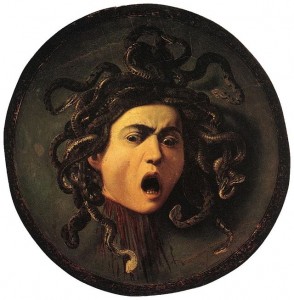Medusa is one of the most famous monsters in Greek mythology, with snakes for hair and eyes that can turn onlookers to stone. But there’s more to her story than being a mere monster for the hero to defeat.
Medusa was one of three Gorgons, three sisters born from the union of two ancient marine gods: Phorcys and his sister Ceto. All three had hair made of venomous snakes and terrifying visages that turned all who met their gaze to stone. Stheno and Euryale were immortal; their sister, Medusa was not.
It’s not surprising then that Medusa is most famous for her death–she was beheaded by the hero Perseus, who used her head as a weapon as it had retained its powers even in her death. He gave the head to the goddess Athena, who placed it on her shield.
You may have seen the 1981 film, Clash of the Titans, where the legendary special effects master Ray Harryhausen created a terrifying stop motion version of Medusa that imagined her as the ancient Greek vase-painters did–as a terrifying monster.
However, by the fifth century BC, artists began to depict her as terrifying yet beautiful, and by Roman times, the myth of Medusa had evolved even further. In his most famous work, Metamorphosis, the poet Ovid describes how Medusa became such a terrible monster:
Medusa was once an exceedingly beautiful maiden
whose hand in marriage was jealously sought by an army of suitors.
According to someone who told me he’d seen it, her marvellous hair
was her crowning glory. The story goes that Neptune the sea god
raped this glorious creature inside the shrine of Minerva.
Jove’s daughter screened her virginal eyes with her aegis in horror,
and punished the sin, by transforming the Gorgon’s beautiful hair
into horrible snakes.’ (That explains why, to startle her foes into terror,
the goddess always displays those snakes on the front of her bosom.)
When I first heard this version of the myth, I was stung by the injustice of it–why was Medusa punished for being the victim of a terrible crime? It really drove home to me how, in Greek and Roman mythology, there are very few repercussions for the gods. Their immortality means their actions have little effect on them, leaving mortals to bear the consequences, for good or ill.
There is another way to look at Medusa’s punishment, however–as well as being a curse, her monstrous powers gave her tools to defend herself. This view could also be supported by the fact that images of Gorgons were often placed on objects and buildings for protection. In fact there was a special amulet in ancient Greece called the Gorgoneion, which could be worn as a protective pendent–it was even worn by the gods Zeus and Hera.
The image of a Gorgon has remained iconic for thousands of years. Even today, the face of Medusa has been adopted by many women as a symbol for female rage and a Gorgoneion head was adopted by Gianni Versace as a logo for his fashion company. 
The rage expressed by Medusa is a futile one; she was either born a monster, or forced to become one. Neither version of the myth gives her any agency or voice, and yet she remains powerful and feared. Medusa is a fascinating mythological girl, to be both feared and pitied.
-Sarah Jackson
Communications Officer
Girl Museum Inc.

